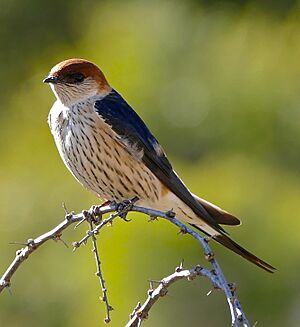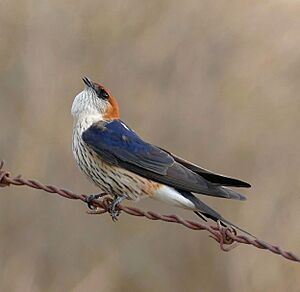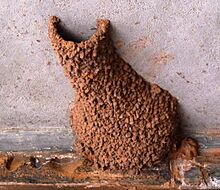Greater striped swallow facts for kids
Quick facts for kids Greater striped swallow |
|
|---|---|
 |
|
| Conservation status | |
| Scientific classification | |
| Genus: |
Cecropis
|
| Species: |
cucullata
|
 |
|
| range
whole year resident (very locally) breeding summer visitor overwintering visitor |
|
| Synonyms | |
|
Hirundo cucullata |
|
The greater striped swallow (Cecropis cucullata) is a large swallow bird. It lives in Africa, south of the equator. These birds are known for their beautiful flight and interesting nests.
Contents
About the Greater Striped Swallow
What's in a Name?
The greater striped swallow got its scientific name, Hirundo cucullata, in 1783. A Dutch scientist named Pieter Boddaert gave it this name. Later, it was placed in a different group, or genus, called Cecropis. This group was created by a German zoologist named Friedrich Boie in 1826.
The word cucullata comes from a Latin word meaning "hooded." This might refer to the bird's head markings.
Appearance and Features
The greater striped swallow is about 18 to 20 centimeters (7 to 8 inches) long. It has dark blue feathers on its back. Its lower back, called the rump, is a light orange color. The top and sides of its head are chestnut brown.
Its belly and the feathers under its wings are creamy white with dark stripes. The main wing feathers are blackish-brown. The tail is blackish and has very long outer feathers. These long feathers are a bit longer on males than on females. Young swallows look duller and browner.
How it Flies and Sounds
This swallow flies slowly and gracefully. Its call is a soft, twittering sound, often described as chissick.
Comparing to Other Swallows
The greater striped swallow looks similar to the smaller lesser striped swallow. However, the greater striped swallow has lighter stripes on its belly. It also has buffy (light yellowish-brown) ear patches, while the lesser striped swallow has reddish-brown ones. The lesser striped swallow also prefers areas with more trees.
Where They Live and Travel
The greater striped swallow breeds in southern Africa. This includes countries like South Africa, Namibia, and southern Zimbabwe. When winter comes, these birds are migratory. They fly north to warmer places like Angola, Tanzania, and the southern Democratic Republic of the Congo.
Preferred Homes
These swallows like dry, open areas such as grasslands. They often prefer hills and mountains. They usually stay away from heavily wooded areas. However, they are often found near human homes and buildings.
Daily Life and Habits
The greater striped swallow is a common bird and is not usually afraid of people. They have actually benefited from living near humans. This is because human buildings offer many good places to build nests.
What They Eat
These birds mainly eat flying insects. They catch their food while flying through the air. Sometimes, they have also been seen eating small fruits.
Reproduction and Life Cycle
The greater striped swallow builds a special nest. It is shaped like a bowl and made of mud pellets. The nest usually has a long, tube-like entrance on the bottom. Inside, the nest is lined with soft materials to keep the eggs and chicks cozy. These nests are often used again in later years.
Where They Build Nests
Swallows might build their nests in natural places like caves or under rock overhangs. They also use fallen trees. However, they often choose human-made structures. These include buildings, bridges, and culverts (tunnels under roads). They usually pick a high spot for their nest if they have a choice.
Eggs and Chicks
A typical clutch has about three eggs. The eggs are shiny white with a few brown spots. Only the female bird sits on the eggs to keep them warm. This is called incubation, and it takes about 17 to 20 days for the eggs to hatch.
Once the chicks hatch, both parents work together to feed them. The young birds stay in the nest for another 23 to 30 days until they are ready to fly. Even after their first flight, the young swallows will often return to the nest to sleep for a few more days.




